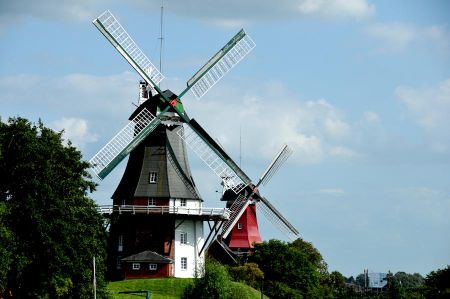Greetsiel - twin mills and traditional fishing boats
- Written by Portal Editor
After our stopover in Suurhusen, it is only 6 kilometers to the city center of Emden. We quickly arrived at Laura's apartment, who was already waiting for us with a coffee.
Because of the wonderful weather, she suggests a day trip to Greetsiel and has made some preparations for a picnic on the dyke. After initial discussions about her studies and life in Emden, we quickly get back to the car and drive via Pewsum to the old fishing port of Greetsiel, which is only 18 kilometers from the city center of Emden.
Stretching out into the Wadden Sea like a tongue
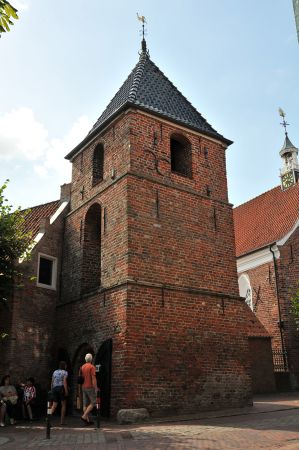 Greetsiel was originally one of a number of fishing villages right on the Leybucht on the East Frisian west coast. In the course of coastal protection measures and embankments for land reclamation, the ports of the other fishing villages disappeared, so that Greetsiel is the only remaining port on the Leybucht today.
Greetsiel was originally one of a number of fishing villages right on the Leybucht on the East Frisian west coast. In the course of coastal protection measures and embankments for land reclamation, the ports of the other fishing villages disappeared, so that Greetsiel is the only remaining port on the Leybucht today.
In the 1980s, the port was still dependent on the tides, comparable to Dangast on the Jade Bay, so that the fishermen could only leave the port with their fishing boats when the tide was high.
When the Leybuchthörn with its lock extending like a tongue into the Wadden Sea was completed in the 1990s, there was a huge reservoir within the dyke, so that today the port is independent of the tides and only the lock to the open sea has to be passed.
Ships from Hamburg at anchor
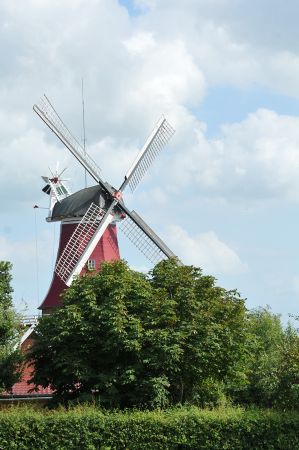 The first tour of the village already gives the impression of a far-reaching past, which on closer inspection covers around 650 years and ultimately goes back to the chieftain of the Cirksena family, who provided the counts and princes of East Frisia from 1464 to 1744.
The first tour of the village already gives the impression of a far-reaching past, which on closer inspection covers around 650 years and ultimately goes back to the chieftain of the Cirksena family, who provided the counts and princes of East Frisia from 1464 to 1744.
But Greetsiel was first mentioned in a document as early as 1388, so it is also known that ships from Hamburg that anchor here had to pay their customs here.
With the birth of Count Edzard the Great in 1462 at Cirksena Castle, a ruler was born who was able to expand East Friesland from Groningen to the Weser during his reign. So it's no wonder that Greetsiel is also listed as "Grietjezijl" on old Dutch maps.
27 wooden shrimp boats
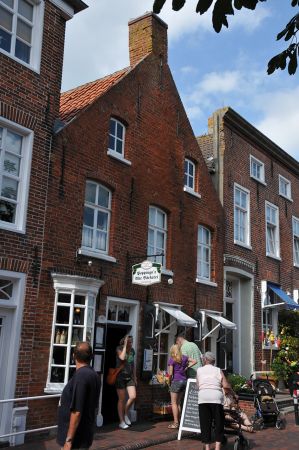 We are now initially drawn to the harbor basin, as a certain feeling of hunger has set in. The benches on the dyke are all occupied by visitors, so we are drawn directly to the edge of the harbor in front of the ferry boat, which is just setting off on a tour, giving us a clear view of the harbour. Our last visit about 20 years ago still showed the tide-dependent harbor where the cutters got stuck on the muddy bottom when the tide was out. Now they lay nicely moored together at the edge of the harbor and presented a grandiose picture. Where else are there 27 wooden shrimp cutters that move up and down in the harbor water almost as if painted. And the whole thing in front of the house front of the old fishermen's houses above the harbor basin, which can probably be described as unique. The sunlight and the white, passing clouds also added to the romance. We enjoyed the picnic prepared by Laura in the fresh air and in front of a wonderful backdrop.
We are now initially drawn to the harbor basin, as a certain feeling of hunger has set in. The benches on the dyke are all occupied by visitors, so we are drawn directly to the edge of the harbor in front of the ferry boat, which is just setting off on a tour, giving us a clear view of the harbour. Our last visit about 20 years ago still showed the tide-dependent harbor where the cutters got stuck on the muddy bottom when the tide was out. Now they lay nicely moored together at the edge of the harbor and presented a grandiose picture. Where else are there 27 wooden shrimp cutters that move up and down in the harbor water almost as if painted. And the whole thing in front of the house front of the old fishermen's houses above the harbor basin, which can probably be described as unique. The sunlight and the white, passing clouds also added to the romance. We enjoyed the picnic prepared by Laura in the fresh air and in front of a wonderful backdrop.
Old bakery of the Poppinga family
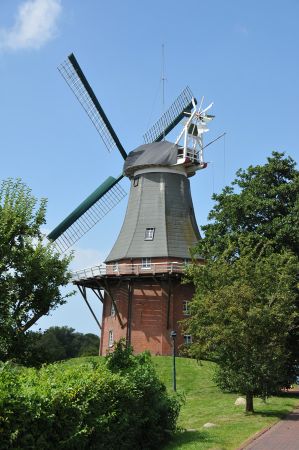 After some time we continued our tour, because there should be other highlights, including the Protestant Reformed Church in the form of a brick hall church, which was equipped with Gothic pointed arch windows between 1380 and 1410 and was used by the chief Haro Edzardna as his own church. At the end of Hohe Straße we come across the former ancestral seat of the Cirksena family, who built the brick house around 1600 on the foundations of the previous house built in 1390. Today, the original hall has been restored in the course of completed renovation work. Of course, the houses on Sielstraße are particularly photogenic, especially the gables of houses number 11 and number 15, which were designed and built according to Dutch models as early as 1741 and 1792. The old bakery of the Poppinga family, which is a little closer to the town center and is now used as a museum, café and gallery, is also worth a visit. In addition to the old shop fittings, it is precisely the many details that catch the eye of the beholder. A visit to the Ship in a Bottle Museum is ideal for rainy days. However, the more than 800 different ships in bottles are a real gem even when the weather is nice, because it is probably the largest collection in Germany.
After some time we continued our tour, because there should be other highlights, including the Protestant Reformed Church in the form of a brick hall church, which was equipped with Gothic pointed arch windows between 1380 and 1410 and was used by the chief Haro Edzardna as his own church. At the end of Hohe Straße we come across the former ancestral seat of the Cirksena family, who built the brick house around 1600 on the foundations of the previous house built in 1390. Today, the original hall has been restored in the course of completed renovation work. Of course, the houses on Sielstraße are particularly photogenic, especially the gables of houses number 11 and number 15, which were designed and built according to Dutch models as early as 1741 and 1792. The old bakery of the Poppinga family, which is a little closer to the town center and is now used as a museum, café and gallery, is also worth a visit. In addition to the old shop fittings, it is precisely the many details that catch the eye of the beholder. A visit to the Ship in a Bottle Museum is ideal for rainy days. However, the more than 800 different ships in bottles are a real gem even when the weather is nice, because it is probably the largest collection in Germany.
Multi-day hiking tours on the canals
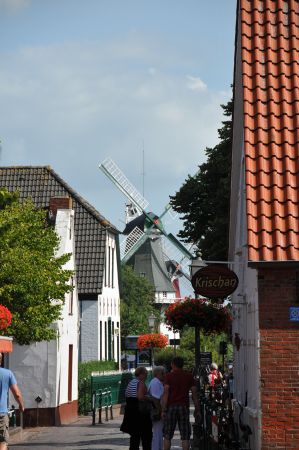 Our tour then takes us further along the old sluice, which the locals refer to as Greetsieler Sieltief, and which connects the town with the East Frisian inland waterway network, so that small boats can still be reached today via Eilsum, Grimersum, Werden and Loppersum to the Knockster Deep and thus can also reach Emden. In the meantime, the connections on the East Frisian waterways have become a real tourist attraction, which canoeists and boats like to use, including for multi-day hiking tours on the canals. A little further along the main sewer you reach the most well-known sights of Greetsiel, the so-called twin mills.
Our tour then takes us further along the old sluice, which the locals refer to as Greetsieler Sieltief, and which connects the town with the East Frisian inland waterway network, so that small boats can still be reached today via Eilsum, Grimersum, Werden and Loppersum to the Knockster Deep and thus can also reach Emden. In the meantime, the connections on the East Frisian waterways have become a real tourist attraction, which canoeists and boats like to use, including for multi-day hiking tours on the canals. A little further along the main sewer you reach the most well-known sights of Greetsiel, the so-called twin mills.
The two windmills of the "Dutch" type are the main attraction in Greetsiel, as both mills date back to the 17th and 18th centuries. Both mills are used today as a café or as a museum, as exhibitions are also held here. The older of the two windmills from 1706, which is called the red mill, had to be renewed in 1921. It was fortunate that many parts from the demolition of the Auricher Wallmühle in 1750 were still available, so that one could work almost exclusively with original parts.
Picnic right at the port
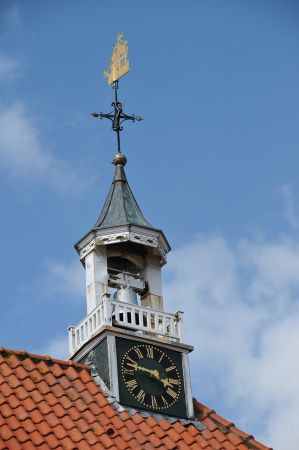 Today more than 1,000,000 visitors are drawn to Greetsiel every year, because the Sieort has become a real attraction, which also has something to do with the Leyhörn nature reserve as part of the Krummhörn bird sanctuary. In addition to extensive water and silt areas, there are large reed areas, tall herb meadows and grassland areas that border on the Lower Saxony Wadden Sea National Park.
Today more than 1,000,000 visitors are drawn to Greetsiel every year, because the Sieort has become a real attraction, which also has something to do with the Leyhörn nature reserve as part of the Krummhörn bird sanctuary. In addition to extensive water and silt areas, there are large reed areas, tall herb meadows and grassland areas that border on the Lower Saxony Wadden Sea National Park.
We really enjoyed this short trip to Greetsiel with our picnic right at the harbor and are driving back to Emden in the evening, as a short stroll through town is also to follow.
Coordinates: 53° 30′ N, 7° 6′ E Coordinates: 53° 30′ 4″ N, 7° 5′ 30″ E
Please also read:
The Leaning Tower of Suurhusen
The goal of today's bike tour - the Imperial Palace of Memleben
-
 Greetsiel - old traditionell fisherman village
Greetsiel - old traditionell fisherman village
Greetsiel - old traditionell fisherman village
Greetsiel - old traditionell fisherman village
-
 Greetsiel - old traditionell fisherman village
Greetsiel - old traditionell fisherman village
Greetsiel - old traditionell fisherman village
Greetsiel - old traditionell fisherman village
-
 Greetsiel - old traditionell fisherman village
Greetsiel - old traditionell fisherman village
Greetsiel - old traditionell fisherman village
Greetsiel - old traditionell fisherman village
-
 Greetsiel - old traditionell fisherman village
Greetsiel - old traditionell fisherman village
Greetsiel - old traditionell fisherman village
Greetsiel - old traditionell fisherman village
-
 Greetsiel - old traditionell fisherman village
Greetsiel - old traditionell fisherman village
Greetsiel - old traditionell fisherman village
Greetsiel - old traditionell fisherman village
-
 Greetsiel - old traditionell fisherman village
Greetsiel - old traditionell fisherman village
Greetsiel - old traditionell fisherman village
Greetsiel - old traditionell fisherman village
-
 Greetsiel - old traditionell fisherman village
Greetsiel - old traditionell fisherman village
Greetsiel - old traditionell fisherman village
Greetsiel - old traditionell fisherman village
-
 Greetsiel - old traditionell fisherman village
Greetsiel - old traditionell fisherman village
Greetsiel - old traditionell fisherman village
Greetsiel - old traditionell fisherman village
-
 Greetsiel - old traditionell fisherman village
Greetsiel - old traditionell fisherman village
Greetsiel - old traditionell fisherman village
Greetsiel - old traditionell fisherman village
-
 Greetsiel - old traditionell fisherman village
Greetsiel - old traditionell fisherman village
Greetsiel - old traditionell fisherman village
Greetsiel - old traditionell fisherman village
-
 Greetsiel - old traditionell fisherman village
Greetsiel - old traditionell fisherman village
Greetsiel - old traditionell fisherman village
Greetsiel - old traditionell fisherman village
-
 Greetsiel - old traditionell fisherman village
Greetsiel - old traditionell fisherman village
Greetsiel - old traditionell fisherman village
Greetsiel - old traditionell fisherman village
https://www.alaturka.info/en/germany/lower-saxony/5669-greetsiel-twin-mills-and-traditional-fishing-boats#sigProId72b8576de5
